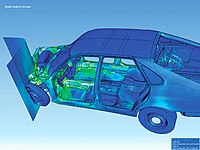
Photo from wikipedia
The growth of fractures around an undercut of a block cave is simulated. A finite element based approach is used, in which fractures are represented as non-planar 3D surfaces that… Click to show full abstract
The growth of fractures around an undercut of a block cave is simulated. A finite element based approach is used, in which fractures are represented as non-planar 3D surfaces that grow in response to boundary stresses and interaction. A new mesh is recreated at each step to compute the displacement field. Stress intensity factors are computed around fracture tips using a technique that computes the interaction integral over a virtual disk. Fracture geometry is updated using Paris and Schöllmann propagation laws, and a geometric fracture pattern ensues from the simulation. The growth of fractures is examined in the lower 20 m of a mine at 812 m depth. The growth of 30, 60 and 90 fractures is examined. Realistic extraction schedules for over 100 draw points control the rate of mass extraction. The effect of rock bridges as overburden stress shields is investigated. Bridges are modelled by constraining the vertical displacement of the top boundary. This case is compared to a Neumann-type overburden stress boundary condition in which the overburden is felt throughout the top of the cave. In both cases, fractures grow to form a dome shape above and around the cave during extraction. For the case of a fixed top boundary, fracture growth is observed away from the cave, while in the direct overburden stress case, fractures tend to grow close to the cave. Over-arching fractures concentric to the undercut continue to grow as the cave progresses.
Journal Title: Geomechanics and Geophysics for Geo-Energy and Geo-Resources
Year Published: 2017
Link to full text (if available)
Share on Social Media: Sign Up to like & get
recommendations!